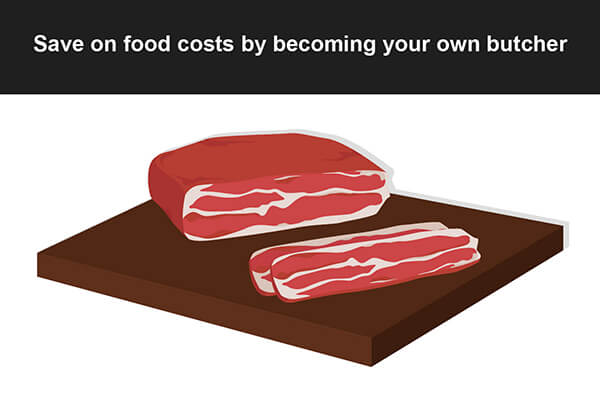August 15, 2020

With rising meat prices, it's more important than ever to keep meat and seafood costs in check. As a restaurant owner you might find yourself asking, “How can I guarantee my guests fair price points without skimping on quality?
The first step to reigning in food costs is to partner with your local restaurant and bulk food supply store. You'll find high-quality meat and seafood at wholesale price points.
Want even more meat saving tips? Read on for more details.
How Can Wholesale Meat Suppliers Help Cut Down on Food Costs?
Are you looking to trim costs and improve the bottom line for your restaurant? Our restaurant supply warehouse shares five top tips to help you shave expenses and deliver on quality.
1. Turn Inexpensive Cuts into High-End Eats
So-called, tough or "peasant" cuts of meat are often overlooked by restaurateurs. However, these thrifty cuts can do wonders for your bottom line and your menu! With a little extra love, you can easily coax out their big flavors. Be on the lookout for these beef and pork options from your wholesale meat suppliers:

Beef
- Chuck: Perfect for pot roast and stews, or turn it into ground beef for burgers, shepherd's pie, and more.
- Flank Steak: Give it a good marinade to help tenderize, then sear or grill at a high temperature, and slice against the grain. This cut is great for carne asada or just sliced thin and served on its own.
- Brisket: Cook it low and slow for dishes like classic BBQ or cure it for pastrami or corned beef.
- Top Sirloin: This versatile cut can be grilled or seared on a flat top and finished in the oven.
Pork
- Belly: Pork belly stands up to a variety of cooking methods: roasting, braising, frying, and more. You can use it in breakfast scrambles, sandwiches, ramen, and roulades.
- Shoulder: Also known as shoulder butt, this cut is perfect for pulled pork, stews, and ragùs. It needs to be cooked on low heat over an extended period of time.
- Loin Roast: Cook it at lower temperatures, and serve it any way you would pork chops or tenderloins.
2. Become Your Own Butcher
Most restaurants don't buy pre-chopped fruits and vegetables because of the higher price tag and lack of in-house quality control, so why should meat and seafood be different? Pre-portioned items like fish fillets, steaks, and poultry breast have a higher price tag. Instead of paying someone else to cut down your meats, let your chefs show off their carving chops.

In-house butchering is a savvy way to save on food costs and build up your foodie reputation. You can easily find whole chicken, large cuts of beef, and more at your restaurant supply store. If the thought of carving large cuts of meat seems daunting or not practical for your restaurant, smart small. Why not grab a tenderloin roast and cut your own filet mignon? Being able to determine the size and thickness also lets you be in more control of portion prices. Pro tip: When cutting down large meat and seafood portions, save bones and any scraps to make your own rich broths for soups and demi-glace.
3. Go for the Gumbo
Comforting stews with developed flavor satisfy customers and help save on meat and seafood expenses. Creating a dish like Chef's Choice Gumbo allows restaurant owners the freedom to incorporate a variety of ingredients and use proteins they have on hand. Go classic with chicken, andouille, and shrimp or go bold with your own version. Why not try sausage, pulled chicken, and local seafood? What makes dishes like gumbo so great is the flavor comes from cooking them low and slow, so you don't have to load up the pot with higher priced proteins.
4. Think Unique
Modern customers are interested in bold flavors, world cuisine, and unique proteins. While it's always important to have beef and pork options, branch out to other, less common meats. In recent years, lamb has been gaining in popularity. This versatile protein can be roasted, braised, frenched, grilled—you name it! Specialty items like lamb can command a higher price tag, allowing you to turn a greater profit. Grind your own lamb for meatballs and burgers, make skewers, or roast a whole rack. Double down on your profits by purchasing your unique meats in bulk from your wholesale meat suppliers.
5. Work with a Single Purveyor
Does your meat and seafood supplier offer other restaurant essentials like produce, bar supplies, dry goods, packaging, and sanitation equipment? If not, you could be spending unnecessary money on purchase minimums and delivery fees per vendor. Choose a restaurant and bulk food supply that is a one-stop shop for quality protein and everything you need for menus and daily operations. Doing all your shopping in one place means you'll save on your bottom line and on time.
Looking to Trim Down Your Restaurant's Meat and Seafood Costs?
Partnering with the restaurant community for over 65 years, US Foods CHEF'STORE offers competitively priced proteins, produce, restaurant supplies and more! Save time on shopping by placing all your orders online via our own Click&Carry system for easy in-store pick up. Need groceries delivered to your door? We also offer third-party delivery options. Shop products today at your local CHEF'STORE.